|
Advisory /
BIOTECHNOLOGY
Home Biotechnology
Risks And Concerns
The introduction of transgenic crops and foods into the existing food production system has generated a number of questions about possible negative consequences. People with concerns about this technology have reacted in many ways, from participating in letter-writing campaigns to demonstrating in the streets to vandalizing institutions where transgenic research is being conducted. What are the main concerns? What scientific support is there for these concerns?
The issues surrounding objections to transgenic crops can be broadly grouped into concerns about
Damage to human health
allergenicity
horizontal transfer and antibiotic resistance
eating foreign DNA
cauliflower mosaic virus promoter
changed nutrient levels
Damage to the natural environment
Monarch butterfly
crop-to-weed gene flow
antibiotic resistance
leakage of GM proteins into soil
reductions in pesticide spraying: are they real?
disruption of current practices of farming and food production in developed countries
crop-to-crop gene flow
These are complex issues and a thorough treatment of each one would occupy volumes. For each topic we provide a short discussion with a link to a longer discussion and outside resources.
[Top]
Concerns about human health
Allergenicity
The possibility that we might see an increase in the number of allergic reactions to food as a result of genetic engineering has a powerful emotional appeal because many of us experienced this problem before the advent of transgenic crops, or know of someone who did.
| However, there is no evidence so far that genetically engineered foods are more likely to cause allergic reactions than are conventional foods. Tests of several dozen transgenic foods for allergenicity have uncovered only a soybean that was never marketed and the now-famous StarLink corn. Although the preliminary finding is that StarLink corn is probably not allergenic, the scientific debate continues. Every year some people discover that they have developed an allergy to a common food such as wheat or eggs, and some people may develop allergies to transgenic foods in the future, but there is no evidence that transgenic foods pose more of a risk than conventional foods do. |
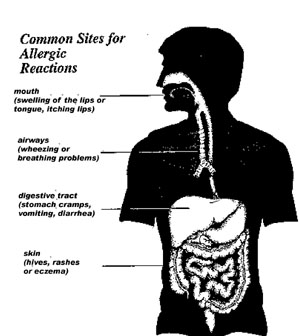 |
Common sites for allergic reactions. Source: FDA
Horizontal transfer and antibiotic resistance
The use of antibiotic resistance markers in the development of transgenic crops has raised concerns about whether transgenic foods will play a part in our loss of ability to treat illnesses with antibiotic drugs. At several stages of the laboratory process, developers of transgenic crops use DNA that codes for resistance to certain antibiotics, and this DNA becomes a permanent feature of the final product although it serves no purpose beyond the laboratory stage. Will transgenic foods contribute to the existing problems with antibiotic resistance?
One aspect  of
this topic is the risk of horizontal gene transfer, that is,
transfer of DNA from one organism to another outside of the
parent-to-offspring channel. Transfer of a resistance gene
from transgenic food to micro-organisms that normally inhabit
our stomach and intestines, or to bacteria that we ingest
along with food, could help those micro-organisms to survive
an oral dose of antibiotic medicine. Although horizontal
transfer of DNA does occur under natural circumstances and
under laboratory conditions, it is probably quite rare in the
acid environment of the human stomach. of
this topic is the risk of horizontal gene transfer, that is,
transfer of DNA from one organism to another outside of the
parent-to-offspring channel. Transfer of a resistance gene
from transgenic food to micro-organisms that normally inhabit
our stomach and intestines, or to bacteria that we ingest
along with food, could help those micro-organisms to survive
an oral dose of antibiotic medicine. Although horizontal
transfer of DNA does occur under natural circumstances and
under laboratory conditions, it is probably quite rare in the
acid environment of the human stomach.
Another concern is that the enzyme product of the DNA might be produced at low levels in transgenic plant cells. While high processing temperatures would inactivate the enzyme in processed foods, ingestion of fresh or raw transgenic foods could result in the stomach containing a small amount of an enzyme that inactivates an orally administered dose of the antibiotic. This issue was raised during the approval processes for Calgene's FlavrSavr tomato and Ciba-Geigy's Bt corn 176. In both cases, tests showed that orally administered antibiotics would remain effective. While the risks from antibiotic resistance genes in transgenic plants appear to be low, steps are being taken to reduce the risk and to phase out their use.
[Top]
Eating foreign DNA
When scientists make a transgenic plant, they insert pieces of DNA that did not originally occur in that plant. Often these pieces of DNA come from entirely different species, such as viruses and bacteria. Is there any danger from eating this "foreign" DNA?
Diagram  of DNA. Source: Foodfuture, Food and Drink Federation of DNA. Source: Foodfuture, Food and Drink Federation
We eat DNA every time we eat a meal. DNA is the blueprint for life and all living things contain DNA in many of their cells. What happens to this DNA? Most of it is broken down into more basic molecules when we digest a meal. A small amount is not broken down and is either absorbed into the blood stream or excreted in the feces. We suspect that the body's normal defense system eventually destroys this DNA. Further research in this area would help to determine exactly how humans have managed to eat DNA for thousands of years without noticing any effects from the tiny bits that sneak into the bloodstream.
So far there is no evidence that DNA from transgenic crops is more dangerous to us than DNA from the conventional crops, animals, and their attendant micro-organisms that we have been eating all our lives.
CaMV promoter
When scientists use transgenic technology to put a new gene into a plant, they put in additional pieces of DNA to direct the activity of that gene. One of these pieces is the "promoter" that turns the gene on.
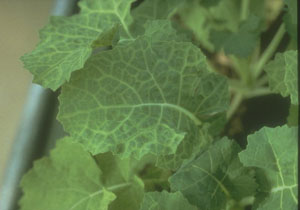 |
The most widely used promoter is the cauliflower mosaic virus 35S promoter, often abbreviated as the CaMV promoter or the 35S promoter. This promoter was obtained from the virus that causes cauliflower mosaic disease in several vegetables, such as cauliflower, broccoli, cabbage, and canola.There are concerns that the CaMV promoter might be harmful if it were to invade our cells and turn on our genes.A
multi-step chain of events would have to occur for the
CaMV promoter to escape the normal digestive breakdown
process |
Cauliflower mosaic virus infection in canola.
Source: Institute National de la Recherche
Agronomique, Versailles-Grignon |
[Top]
penetrate a cell of the body,
and insert itself into a human chromosome. While there have been no tests to determine whether the CaMV promoter has invaded human tissues, experiments with mice indicate that normal body defenses eliminate stray fragments of foreign DNA that sneak into the blood stream from the digestive tract.
There is some evidence that the CaMV promoter poses little threat to human health. People have been eating it in small quantities for hundreds of years when we eat vegetables that are infected with the disease. Although vegetables heavily infected with CaMV are unappetizing, there have been no documented negative effects on health from eating the virus or its promoter.
Changed nutrient levels
How do genetically engineered foods compare with conventional foods in nutritional quality? This is an important issue, and one for which there will probably be much research in the future, as crops that are engineered specifically for improved nutritional quality are marketed. However, there have been only a few studies to date comparing the nutritional quality of genetically modified foods to their unmodified counterparts.
The central question for GE crops that are currently available is whether plant breeders have accidentally changed the nutritional components that we associate with conventional cultivars of a crop. Because isoflavones are thought to play a role in preventing heart disease, breast cancer, and osteoporosis, the isoflavone content of RoundupReady soybeans has been investigated by several researchers.
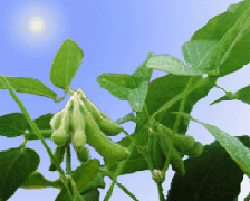
The studies completed so far do not resolve the issue of whether RoundupReady soybeans have isoflavone levels comparable to conventional varieties, but the differences found in experiments appear to be small or moderate in comparison with natural variation in isoflavone levels. Additional evidence may clarify the arguments for and against Roundup applications as a risk factor in soybean cultivation.
Industry studies submitted in support of applications for permission to sell transgenic crops indicate that the nutritional components that are commonly tested are similar in transgenic foods and conventional foods.
Concerns about damage to the environment
Monarch butterfly
 |
The
suggestion that Bt corn pollen might kill Monarch
butterfly larvae galvanized public interest in the
effect of transgenic crops on the environment. We
present a full discussion of this issue under Hot
Topics: Monarch Butterfly. |
[Top]
Crop-to-weed gene flow
Hybridization of crops with nearby weeds may enable weeds to acquire traits we wish they didn't have, such as resistance to herbicides. Research results indicate that crop traits may escape from cultivation and persist for many years in wild populations. Genes that provide a competitive edge, such as resistance to viral disease, could benefit weed populations around a crop field.
Many cultivated crops have sexually compatible wild relatives with which they hybridize under favorable circumstances. The likelihood that transgenes will spread can be different for each crop in each area of the world.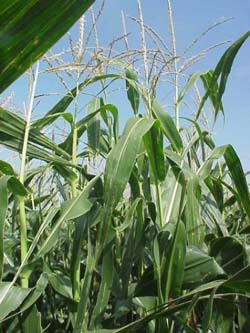
For example, there are no wild relatives of corn in the United States or in Europe for transgenic corn to pollinate, but such wild relatives exist in Mexico.
Soybeans and wheat are self-pollinating crops, so the risk of transgenic pollen moving to nearby weeds is small. However, that small risk must balanced against the fact that there are wild relatives of wheat in the United States.
There are no wild relatives of soybean in the United States, but such wild relatives exist in China. Thus each crop must be evaluated individually for the risk of gene flow in the area where it will be grown.
More on crop-to-weed gene flow
Antibiotic resistance
There is also concern that transgenic plants growing in the field will transfer their antibiotic resistance genes to soil micro-organisms, thus causing a general increase in the level of antibiotic resistance in the environment. However, many soil organisms have naturally occurring resistance as a defense against other organisms that generate antibiotics, so genes contributed occasionally by transgenic plants are unlikely to cause a change in the existing level of antibiotic resistance in the environment.
[Top]
Leakage  of GM proteins into soil of GM proteins into soil
Many plants leak chemical compounds into the soil through their roots. There are concerns that transgenic plants may leak different compounds than conventional plants do, as an unintended consequence of their changed DNA.
Speculation that this may be happening leads to concern about whether the communities of micro-organisms living near transgenic plants may be affected. The interaction between plants and soil micro-organisms is very complex, with the micro-organisms that live around plant roots also leaking chemical compounds into the soil. Much more research must be done before we understand the relationships that occur between micro-organisms and conventional crops. Attempts to discover whether transgenic plants are changing the soil environment, and whether they are changing it in good ways or bad ways, are hindered by our lack of basic scientific knowledge.
Reductions in pesticide spraying: are they real?
| One of the most appealing arguments in favor of
transgenic plants is the potential for reducing the damage we do to our environment with conventional methods of farming. Pest-resistant crops such as Bt corn and Bt cotton have been promoted as a means to reduce the spraying of pesticides, while herbicide-tolerant crops such as RoundupReady soybeans are said to reduce the application of herbicides. Large reductions in chemical spraying have been claimed to result from the introduction of these transgenic varieties. Are the claims true? |
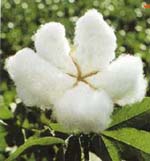 |
Bt cotton is the only crop for which claims of reduced spraying are clear. Analysts paint a mixed picture on the results of planting RoundupReady soybeans. Bt corn and herbicide-tolerant cotton and corn have not resulted in clear reductions in the spraying of chemicals.
Concerns about damage to current farming practices
Crop-to-crop gene flow
Hybridization of transgenic crops with nearby conventional crops raises concerns about separation distances to ensure purity of crops and about who must pay if unwanted genes move into a neighbor's crop. As "Identity Preservation" and segregation of GM from non-GM crops become factors in marketing products, it will be important to ensure that hybridization is not occurring in the field.
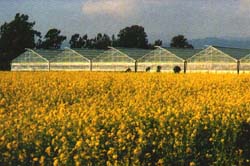 Many factors influence the potential for gene flow from crop to crop. Some crops are highly
outcrossing, with pollen carried to other fields by wind and by insects. Other species are highly self-pollinating, with little potential for pollen transfer to neighboring plants. Because of the differences among crops species, every case must be evaluated individually for potential to contribute to gene flow from transgenic to conventional crops. Many factors influence the potential for gene flow from crop to crop. Some crops are highly
outcrossing, with pollen carried to other fields by wind and by insects. Other species are highly self-pollinating, with little potential for pollen transfer to neighboring plants. Because of the differences among crops species, every case must be evaluated individually for potential to contribute to gene flow from transgenic to conventional crops.
If GM pollen pollinates plants in a neighboring field, then the issue of genetic trespass may arise. What level of GM presence, if any, should be allowed in products that are sold as organic or conventional? Should GM farmers and companies bear responsibility for preventing gene flow, or should conventional and organic farmers pay to protect their products from gene flow? Should GM versions of outcrossing plants be banned as too risky, while GM versions of self-pollinating plants are permitted? These issues have already prompted several lawsuits and they will continue to be a factor in the development and use of trangenic plants for years to come.
Source:
colostate.edu |
Pakissan.com;
|